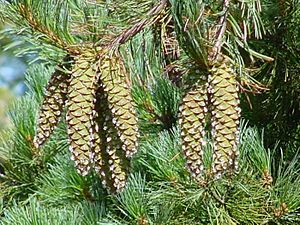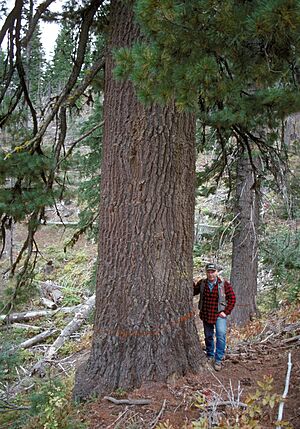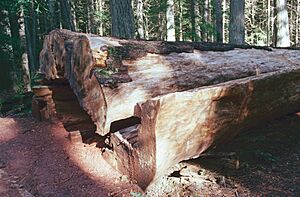Western white pine facts for kids
Quick facts for kids Western white pinePinus monticola |
|
|---|---|
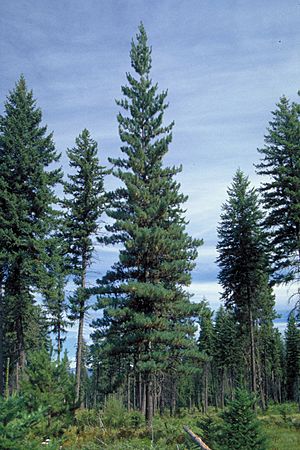 |
|
| Western white pine (center) | |
| Conservation status | |
| Scientific classification | |
| Genus: |
Pinus
|
| Species: |
monticola
|
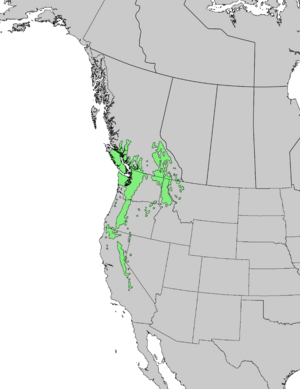 |
|
The Western white pine (Pinus monticola) is a tall tree found in the mountains of western United States and Canada. It is also known by other names like silver pine and California mountain pine. This tree grows in places like the Sierra Nevada, the Cascade Range, the Coast Range, and the northern Rocky Mountains. In some areas, especially in Oregon and Washington, it can even grow near the sea. The Western white pine is the official state tree of Idaho, which is why it's sometimes called the Idaho pine.
Contents
What is the Western White Pine?
The Western white pine is a very large tree. It often grows to be about 30 to 50 meters (100 to 165 feet) tall. Some can even reach an amazing 70 meters (230 feet)! This tree is part of a group called "white pines."
Needles and Cones
Like all white pines, its leaves, which are called 'needles', grow in bundles of five. These bundles have a small cover at their base that falls off. The needles are slightly rough and are about 5 to 13 centimeters (2 to 5 inches) long.
The cones of the Western white pine are long and thin. They are usually 12 to 32 centimeters (5 to 13 inches) long when closed. When they open, they become wider, about 5 to 8 centimeters (2 to 3 inches) across. The scales on the cones are thin and can bend easily. Inside the cones are small seeds, about 4 to 7 millimeters (0.16 to 0.28 inches) long. Each seed has a long, thin wing, about 15 to 22 millimeters (0.59 to 0.87 inches) long, which helps it fly away in the wind.
How is it Different from Other Pines?
The Western white pine is related to the Eastern white pine. However, it has some differences. Its cones are larger, and its needles stay on the tree a bit longer (2 to 3 years instead of 1.5 to 2 years). The Western white pine also tends to be denser and narrower in shape. Its branches grow in neat circles, one circle each year. This is easy to see in trees that grow close together. People often plant this tree for its beauty, but in the past, many were cut down for wood.
Threats to the Western White Pine
The Western white pine has faced a serious threat from a fungus called white pine blister rust. This fungus came from Europe by accident in 1909. It has caused a lot of damage.
The Blister Rust Problem
Experts believe that about 90% of Western white pines west of the Cascades have been killed by this blister rust. Because of this, other types of pine trees or different kinds of trees have grown in their place. The rust has also harmed many whitebark pines. However, in California, the blister rust is not as bad, and many Western white and whitebark pines have survived there.
Finding Resistant Trees
Some Western white pines are naturally stronger against the blister rust. This is because of their genes. The United States Forest Service has a special program. They look for and breed Western white pines and sugar pines that are resistant to the rust. Young trees grown from these resistant parents are then planted in the wild to help the forests recover.
Images for kids
See also
 In Spanish: Pino blanco occidental para niños
In Spanish: Pino blanco occidental para niños



